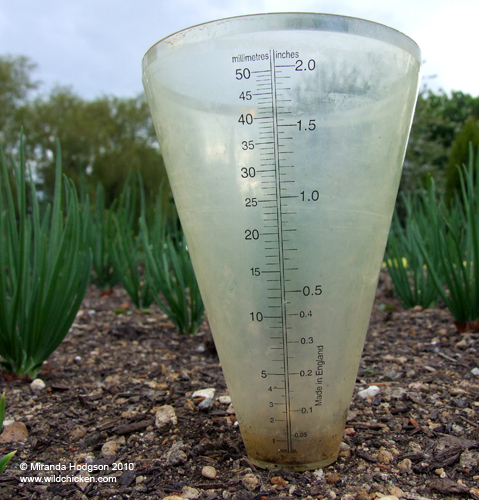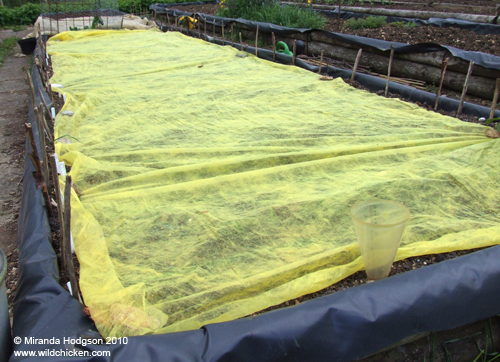The vegetable garden in May - what to do now
April was a very dry month in Witney and I think we only had one or two showers for the whole month. A rain gauge is very useful in helping to judge how much to water as it measures the amount of rain that reaches soil level. Mine has remained dry for much of the past month, so Iíve been out watering more often than usual.
The nights are still cold and our clay soil isnít warming up very quickly, so putting down fleece over soil where seeds have been sown will give a bit of a boost to growth by keeping the soil that little bit warmer.

Not much rain in this gauge for the past month
Vegetables to plant out
Brussels sprouts, cabbages, cauliflower, celeriac, Kohl rabi, leeks, lettuce, peas, potatoes, rhubarb.
Vegetables that can be started now, in the ground, from seed
Sweet corn, purple sprouting broccoli, cauliflower, Kohl rabi, lettuce, peas, runner and French beans, gherkins, kale, courgettes and other squashes, chicory, Chinese leaf, pak choi.
When salads, broad beans and peas are 5cm (2 inches) high, sow another batch of seeds for a succession of fresh vegetables, hopefully avoiding a glut and preventing your neighbours from avoiding you for fear of being given another marrow/bag of broad beans/bushel of lettuce.
Seeds to start under cover
Sow small batches of herb seeds for a succession of fresh herbs till the end of the season. Mediterranean basil, Thai basil, coriander, chervil, parsley, dill and sorrel can all be sown now. Thyme, rosemary and sage are also easy to grow from seed and will make useable plants by the end of summer.
Things to do
Harden off seedlings to prepare them for going in the ground by putting them outside during the day and putting them under cover again at night Ė usually for 10-14 days. You can also put them in a cold frame and the leave the lid open during the day. Only plant out when the danger of frost has passed.
Earth up potatoes once the foliage reaches about 23cm (9 inches) high. Do this by drawing the soil up around the plant, leaving 5cm (2 inches) of leaf poking out of the top. This will prevent potatoes growing near the surface from turning green and will increase the crop.
Pot on tender seedlings like tomatoes, aubergines and peppers to ready them for growing outside by early to mid-June.
Thin out seedlings Ė carrots especially benefit from being given the room to swell their roots, but be careful to remove all the thinnings to reduce the risk of attracting carrot fly.
There has been very little rain for the last month, so water regularly to ensure that plants are kept moist. Water in the evening or early morning to make certain that plants get what they need before the surface moisture evaporates.
Keep on top of weed growth by hoeing often. Sharpening the hoe blade will make the job easier and faster.
Keep a watch on the weather forecasts and if frost is forecast, cover tender seedlings with fleece. Newspaper held down with stones or old net curtains will also work.
Collect sticks and long twigs for peas to scramble over. Prunings from the garden are ideal.

Cover the seed bed with fleece to help keep the soil warm and speed up seedling growth
Things to watch out for
Once again, those slugs and snails are active and looking towards your tender young seedlings. Pick them off and dispose of them in the way that seems least gruesome to you, or use beer traps. If you have chickens, they will appreciate slugs as a juicy treat and make short work of them, but donít be tempted to let the chickens into the vegetable garden as they also enjoy young seedlings.
Cabbage white butterflies are on the wing now and will be attracted to all plants of the cabbage family, where they will lay hundreds of eggs. Cabbages can be netted or you can construct a framework of wood and netting to place over them. This will protect the plants and prevent them being eaten by caterpillars. If you do spot caterpillars on your cabbages, pick them off and destroy them or give them to your chickens.
Netting cabbages will also protect them from pigeons, who find them a good food and who probably go out for breakfast earlier than many of us.
Water cabbage plants regularly to ensure that they are strong enough to grow through the phase of flea beetles that will be starting. Flea beetles are very small black beetles that chew tiny holes in young cabbage seedlings.
If cats come into your garden, they will find your seed beds an ideal toilet and can cause a lot of mess and damage. Poking sticks into the ground deters them from squatting amongst your seedlings. Laying down prunings from thorny plants such as Berberis or Pyracantha also helps.
© Copyright Miranda Hodgson 2010